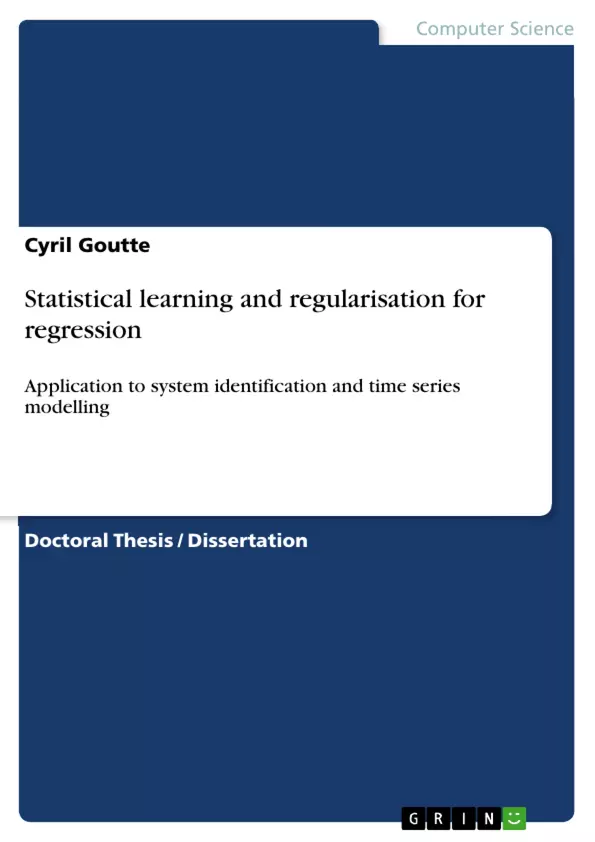Unravel the complexities of data-driven modeling and step into the realm where accuracy meets resilience in the face of uncertainty. This groundbreaking work delves deep into the heart of statistical learning and regularization, offering a transformative perspective on regression techniques. Discover how these powerful methods can revolutionize system identification and time series modeling, unlocking unprecedented levels of precision and reliability. Explore cutting-edge approaches to model parameter estimation, fortified by rigorous mathematical frameworks and innovative algorithms designed to combat overfitting and enhance generalization. Witness the evolution of model robustness as regularization techniques are meticulously applied to mitigate the impact of noisy data and spurious correlations. This research bridges the gap between theoretical advancements and practical applications, providing invaluable insights for researchers and practitioners alike. Whether you're grappling with the intricacies of dynamic systems or seeking to forecast future trends, this exploration of statistical learning, regularization, and regression will equip you with the tools and knowledge to conquer even the most challenging modeling tasks. Journey through the landscape of data analysis, guided by a comprehensive treatment of both established techniques and novel methodologies, and emerge with a profound understanding of how to build models that are not only accurate but also resilient and insightful. From the foundations of regression to the frontiers of system identification and time series analysis, this is your compass for navigating the ever-evolving world of data-driven decision-making. Prepare to challenge conventional wisdom, embrace the power of regularization, and unlock the true potential of your data. The exploration of statistical learning and its pivotal role in fortifying regression models within the realms of system identification and time series modeling will empower readers to construct models characterized by unparalleled precision and dependability. By navigating the nuances of parameter estimation and employing advanced regularization strategies, this thesis equips you to develop models robust enough to resist the detrimental impact of noisy data and misleading correlations. It is an essential resource for anyone committed to harnessing the full potential of data for informed decision-making and innovative solutions.
Inhaltsverzeichnis (Table of Contents)
- Acknowledgements
- Introduction
- Notation
Zielsetzung und Themenschwerpunkte (Objectives and Key Themes)
This doctoral thesis aims to explore statistical learning and regularization techniques for regression problems, with applications in system identification and time series modeling. The research investigates methods to improve the accuracy and robustness of models built from data.
- Statistical learning methods for regression
- Regularization techniques to improve model robustness
- Application to system identification
- Application to time series modeling
- Model parameter estimation
Zusammenfassung der Kapitel (Chapter Summaries)
Acknowledgements: This chapter expresses gratitude to various individuals and institutions for their support and contributions throughout the author's doctoral research. Specific thanks are extended to the thesis advisor, Professor Patrick Gallinari, for his guidance and support, as well as to Professor Lars Kai Hansen for his mentorship during a research stay in Denmark. The author also acknowledges the contributions of the jury members and other colleagues who provided helpful discussions and feedback. Finally, a personal acknowledgment is made to the author's wife for her unwavering support.
Introduction: This introductory chapter sets the stage for the thesis by providing an overview of the problem of regression and its applications in system identification and time series modeling. It introduces the concept of statistical learning and regularization, outlining the challenges and opportunities within this field. It establishes the context for the research presented in the following chapters and provides a brief roadmap for the thesis structure. The importance of accurate and robust model building is emphasized, highlighting the motivation behind the work presented.
Notation: This section defines the mathematical notation used throughout the thesis. It lists key symbols and their meanings, including those related to system input and output, model parameters, error estimation, and probability distributions. This ensures consistency and clarity in the mathematical formulations presented in subsequent chapters. The careful definition of notation is crucial for the rigorous treatment of the mathematical concepts involved in the research.
Schlüsselwörter (Keywords)
Statistical learning, regularization, regression, system identification, time series modeling, parameter estimation, model robustness, data analysis.
Häufig gestellte Fragen
What is the purpose of this document?
This document is a language preview of a doctoral thesis focusing on statistical learning and regularization techniques for regression problems, with applications in system identification and time series modeling. It includes the table of contents, objectives, key themes, chapter summaries, and keywords.
What are the main topics covered in this thesis?
The main topics covered include statistical learning methods for regression, regularization techniques to improve model robustness, application to system identification, application to time series modeling, and model parameter estimation.
What does the "Acknowledgements" chapter contain?
The "Acknowledgements" chapter expresses gratitude to individuals and institutions for their support during the author's doctoral research. It specifically thanks the thesis advisor, Professor Patrick Gallinari, Professor Lars Kai Hansen, jury members, colleagues, and the author's wife.
What does the "Introduction" chapter cover?
The "Introduction" chapter provides an overview of regression and its applications in system identification and time series modeling. It introduces statistical learning and regularization, outlining challenges and opportunities in the field. It also establishes the context for the research and provides a roadmap for the thesis structure.
What is the purpose of the "Notation" section?
The "Notation" section defines the mathematical notation used throughout the thesis, including key symbols and their meanings related to system input and output, model parameters, error estimation, and probability distributions.
What are the keywords associated with this thesis?
The keywords associated with this thesis are: Statistical learning, regularization, regression, system identification, time series modeling, parameter estimation, model robustness, and data analysis.
What type of research is presented in this document?
The document outlines research related to statistical learning, regularization techniques, and their application to regression problems, particularly in the contexts of system identification and time series modeling. The goal is to improve the accuracy and robustness of models built from data.
- Quote paper
- Cyril Goutte (Author), 1997, Statistical learning and regularisation for regression, Munich, GRIN Verlag, https://www.grin.com/document/358916



